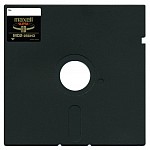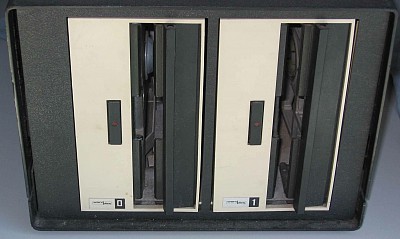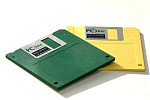Computer Science
Computing History Displays: Fifth Floor - Magnetic Data Storage - Floppy Disks
The IBM System/360 computer of the 1960s made great use of read-only memories to hold microcode. The speed of the read-only memory varied with the performance of the processor - each model class had its own memory technology. The designers of the successor System/370 made a decision to use a single variety of electronic integrated circuit read/write memory to hold microprograms for all models. This led to the problem of how to get the microcode into memory when the computer was started - the Initial Control Program Load (ICPL.) They decided to design a magnetic memory to hold the microcode so that it could be read and loaded when required.
This led to development of what became called the "floppy disc" drive. With floppy disks the magnetic medium is flexible and its lubricated surface is pressed against the read head rather then riding above the rigid medium surface as with a hard disk. The diskette is enclosed in a semi-rigid envelope that protects the surface and has a slot through which the diskette is read. The diskettes are interchangeable - the drive grips the diskette medium with a clamp over a cone in the central hole and the disk drive does not rotate except when data is being read, thus avoiding wear. The first diskettes (23FD) could hold only 81.6 KB. As well as for the System/370 microcode, they were used to hold control programs for the IBM 3330 hard disk controller.
The success of this technology led to it being adapted other applications. With computers of the time, getting new data into the computer system was awkward. Time-sharing systems were not powerful enough to be used to enter data on-line. Punched cards were used universally for data entry though there were devices that allowed data to be stored directly to magnetic tape, quite suitable for large volumes of data. It was thought that a floppy disk that could be written as well as read would provide a replacement for cards. The ICPL disk and diskette were revamped in a slightly larger 8 inch square diskette package, made writable and improved to allow storage of 243KB. This was delivered in the IBM 3740 Data Entry station in 1973. This was the "8 inch floppy" - the initial 33-FD model underwent further improvements to the 43-FD of 568 KB and the 53-FD of 1 MB in 1977.
The floppy disk did eventually see the end of punched cards for data entry. However, its introduction was timely in that the floppy was also available to be used as the main long-term storage device for the first personal computers. The impact of floppies was much increased by Shugart Associates introduction of a smaller, less-expensive, 5 1/4 inch version in 1976. This started with a capacity of 81 KB, also increasing in stages to a capacity of 1 MB in 1981. All of the early personal computers, Apple and IBM included, used 5 1/4 inch floppy drives.
A last stage of mainline floppy development was Sony's introduction of the 3 1/2 inch floppy in 1981. This had a closable window to protect the surface and metal hub to allow more precise gripping of the medium. It started with 322 KB and also increased in stages to well over 1MB. The 3 1/2 inch floppy was first used with the Apple Macintosh in 1984 and soon became the main interchangeable storage medium for personal computers for the next 10-20 years.
The floppy diskette did not have the capacity to store graphic data so it was gradually phased-out in favour of technologies with greater capacity. Apple made CD drives standard in all of its computers by 1994 and discontinued the floppy with the iMac in 1998. Other PCs have continued to support the floppy disk for interchange of small amounts of data but it now has been effectively replaced by flash-memories - an all-electronic technology.
Although the main line of floppy development ended with the 3 1/2 inch profile, there were other developments of the technology that were of significant use in the period before flash-memories. One problem with the floppy is holding the medium rigid while it rotates at speed. A solution to this problem is to rotate the floppy disk above a rotating rigid disk and force air to flow from the hub to the rim in the gap - the Bernouilli principle causes a vacuum that sucks the floppy surface tightly against the rigid disk. Development of this principle led to a series of drives and diskettes with capacities of up to 100MB, the IOMega ZIP drive in particular.
One last mention should be made of the ubiquitous use of magnetic recording of data on magnetic stripes in credit cards and the like. Now everybody uses magnetic data storage every day, it has become so commonplace that we do not think about it at all.






